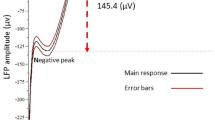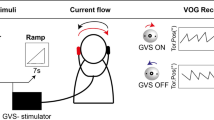Abstract
Contemporary studies speculated that cerebellar network responsible for motion perception projects to the cerebral cortex via vestibulo-thalamus. Here, we sought for the physiological properties of vestibulo-thalamic pathway responsible for the motion perception. Healthy subjects and the patient with focal vestibulo-thalamic lacunar stroke spun a hand-held rheostat to approximate the value of perceived angular velocity during whole-body passive earth-vertical axis rotations in yaw plane. Vestibulo-ocular reflex was simultaneously measured with high-resolution search coils (paradigm 1). In primates, the vestibulo-thalamic projections remain medial and then dorsomedial to the subthalamus. Therefore, the paradigm 2 assessed the effects of high-frequency subthalamic nucleus electrical stimulation through the medial and caudal deep brain stimulation electrode in five subjects with Parkinson’s disease. Paradigm 1 discovered directional mismatch of perceived rotation in a patient with vestibulo-thalamic lacune. There was no such mismatch in vestibulo-ocular reflex. Healthy subjects did not have such directional discrepancy of perceived motion. The results confirmed that perceived angular motion is relayed through the thalamus. Stimulation through medial and caudal-most electrode of subthalamic deep brain stimulator in paradigm 2 resulted in perception of rotational motion in the horizontal semicircular canal plane. One patient perceived riding a swing, a complex motion, possibly the combination of vertical canal and otolith-derived signals representing pitch and fore-aft motion, respectively. The results examined physiological properties of the vestibulo-thalamic pathway that passes in proximity to the subthalamic nucleus conducting pure semicircular canal signals and convergent signals from the semicircular canals and the otoliths.



Similar content being viewed by others
References
Yakusheva TA, Shaikh AG, Green AM, Blazquez PM, Dickman JD, Angelaki DE. Purkinje cells in posterior cerebellar vermis encode motion in an inertial reference frame. Neuron. 2007;54:973–85. doi:10.1016/j.neuron.2007.06.003.
Shaikh AG, Palla A, Marti S, Olasagasti I, Optican LM, Zee DS, Straumann D. Role of cerebellum in motion perception and vestibulo-ocular reflex-similarities and disparities. Cerebellum. 2013;12:97–107. doi:10.1007/s12311-012-0401-7.
Shaikh AG, Meng H, Angelaki DE. Multiple reference frames for motion in the primate cerebellum. J Neurosci. 2004;24:4491–7. doi:10.1523/JNEUROSCI.0109-04.2004.
Shaikh AG, Green AM, Ghasia FF, Newlands SD, Dickman JD, Angelaki DE. Sensory convergence solves a motion ambiguity problem. Curr Biol. 2005;15:1657–62. doi:10.1016/j.cub.2005.08.009.
Shaikh AG. Motion perception without nystagmus—a novel manifestation of cerebellar stroke. J Stroke Cerebrovasc Dis. 2014;23:1148–56. doi:10.1016/j.jstrokecerebrovasdis.2013.10.005.
Green AM, Shaikh AG, Angelaki DE. Sensory vestibular contributions to constructing internal models of self-motion. J Neural Eng. 2005;2:S164–79. doi:10.1088/1741-2560/2/3/S02.
Angelaki DE, Shaikh AG, Green AM, Dickman JD. Neurons compute internal models of the physical laws of motion. Nature. 2004;430:560–4. doi:10.1038/nature02754.
Bertolini G, Wicki A, Baumann CR, Straumann D, Palla A. Impaired tilt perception in Parkinson’s disease: a central vestibular integration failure. PLoS One. 2015;10:e0124253. doi:10.1371/journal.pone.0124253.
Bertolini G, Ramat S, Laurens J, Bockisch CJ, Marti S, Straumann D, Palla A. Velocity storage contribution to vestibular self-motion perception in healthy human subjects. J Neurophysiol. 2011;105:209–23. doi:10.1152/jn.00154.2010.
Bertolini G, Ramat S, Bockisch CJ, Marti S, Straumann D, Palla A. Is vestibular self-motion perception controlled by the velocity storage? Insights from patients with chronic degeneration of the vestibulo-cerebellum. PLoS One. 2012;7:e36763. doi:10.1371/journal.pone.0036763.
Yousif N, Bhatt H, Bain PG, Nandi D, Seemungal BM. The effect of pedunculopontine nucleus deep brain stimulation on postural sway and vestibular perception. Eur J Neurol. 2016; doi:10.1111/ene.12947.
Seemungal BM, Masaoutis P, Green DA, Plant GT, Bronstein AM. Symptomatic recovery in miller fisher syndrome parallels vestibular-perceptual and not vestibular-ocular reflex function. Front Neurol. 2011;2:2. doi:10.3389/fneur.2011.00002.
Meng H, May PJ, Dickman JD, Angelaki DE. Vestibular signals in primate thalamus: properties and origins. J Neurosci. 2007;27:13590–602. doi:10.1523/JNEUROSCI.3931-07.2007.
Meng H, Angelaki DE. Responses of ventral posterior thalamus neurons to three-dimensional vestibular and optic flow stimulation. J Neurophysiol. 2010;103:817–26. doi:10.1152/jn.00729.2009.
Liu S, Yakusheva T, Deangelis GC, Angelaki DE. Direction discrimination thresholds of vestibular and cerebellar nuclei neurons. J Neurosci. 2010;30:439–48. doi:10.1523/JNEUROSCI.3192-09.2010.
Kleine JF, Guan Y, Kipiani E, Glonti L, Hoshi M, Buttner U. Trunk position influences vestibular responses of fastigial nucleus neurons in the alert monkey. J Neurophysiol. 2004;91:2090–100. doi:10.1152/jn.00849.2003.
Hawrylyshyn PA, Rubin AM, Tasker RR, Organ LW, Fredrickson JM. Vestibulothalamic projections in man—a sixth primary sensory pathway. J Neurophysiol. 1978;41:394–401.
Nigmatullina Y, Hellyer PJ, Nachev P, Sharp DJ, Seemungal BM. The neuroanatomical correlates of training-related perceptuo-reflex uncoupling in dancers. Cereb Cortex. 2015;25:554–62. doi:10.1093/cercor/bht266.
Bergamin O, Zee DS, Roberts DC, Landau K, Lasker AG, Straumann D. Three-dimensional Hess screen test with binocular dual search coils in a three-field magnetic system. Invest Ophthalmol Vis Sci. 2001;42:660–7.
Okada T, Grunfeld E, Shallo-Hoffmann J, Bronstein AM. Vestibular perception of angular velocity in normal subjects and in patients with congenital nystagmus. Brain. 1999;122(Pt 7):1293–303.
Straumann D. Off-line computing of slow-phase eye velocity profiles evoked by velocity steps or caloric stimulation. Int J Biomed Comput. 1991;29:61–5.
Baier B, Vogt T, Rohde F, Cuvenhaus H, Conrad J, and Dieterich M. Deep brain stimulation of the nucleus ventralis intermedius: a thalamic site of graviceptive modulation. Brain Struct Funct. 2015.
Mike A, Balas I, Varga D, Janszky J, Nagy F, Kovacs N. Subjective visual vertical may be altered by bilateral subthalamic deep brain stimulation. Mov Disord. 2009;24:1556–7.
Acknowledgements
The authors thank Mahlon DeLong, MD and Andre Machado, MD, PhD for the insights and support. Aasef Shaikh was supported by Dystonia Coallition/Dystonia Medical Research Foundation Career Development award and Dystonia Medical Research Foundation clinical fellowship.
Author information
Authors and Affiliations
Corresponding author
Ethics declarations
Compliance with Ethical Standards
The experimental protocol was approved by an ethics committee of the Canton of Zurich and adhered to the Declaration of Helsinki for research involving human subjects.
Disclosure and Conflict of Interest
The authors have no conflict of interests of financial disclosures other than funding support mentioned in Acknowledgements.
Rights and permissions
About this article
Cite this article
Shaikh, A.G., Straumann, D. & Palla, A. Motion Illusion—Evidence towards Human Vestibulo-Thalamic Projections. Cerebellum 16, 656–663 (2017). https://doi.org/10.1007/s12311-017-0844-y
Published:
Issue Date:
DOI: https://doi.org/10.1007/s12311-017-0844-y




